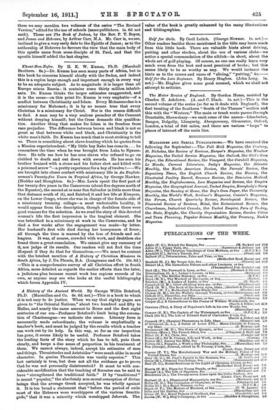Khont - Non - Nofer. By H. K. W. Kumm, Ph.D. (Marshall Brothers. -
6s.)—Dr. Kumm has seen many parts of Africa, but in this book he concerns himself chiefly with the Sudan, and indeed this is a region large enough and important enough in every way to be an adequate subject. As to magnitude it is larger than all Europe minus Russia : it contains some thirty million inhabit- ants. Dr. Kumm thinks the larger estimates exaggerated, and it is the scene—on this point Dr. Kumm is very emphatic—of a conflict between Christianity and Islam. Every Mohammedan is a missionary for Mehemet ; it is by no means true that every Christian is a missionary for Christ. Nor is the reason difficult to find. A man may be a very zealous preacher of the Crescent without denying himself; but the Cross demands this qualifica- tion. Another thing that makes for Islam is its freedom from race prejudice. The difference between brown and black is not so great as that between white and black, and Christianity is the white man's faith. Dr. Kumm has much that is most striking to tell us. There is something about slave-hunting which he quotes from a Mission superintendent : "My little boy Rabe has come in . . . he remembers the time when he was brought from Lake to Ngaum- dere. He tells me how he has seen slaves who refused to go on clubbed to death and cut down with swords. He has seen his brother brained with a stone and his father shot and killed with a poisoned arrow "—a pretty experience for a boy of twelve !—We aro brought into closer contact with missionary life in An English- woman's Twenty-five Years in. Tropical Africa, by George Hawker. (Hodder and Stoughton. 6s.)—Mrs. Lewis spent the first part of her twenty-five years in the Cameroons (about five degrees north of the Equator), the second at or near San Salvador (a little more than that distance south of it), and finished it and her life at Kimpere, on the Lower Congo, where she was in charge of the female side of a missionary training college—a most undesirable locality, it would appear from the description, though doubtless there were good reasons for the selection. As we read the story of this devoted woman's life the first impression is the tragical element. She was betrothed to a missionary at work in the Cameroons, and he died a few weeks after the engagement was made—by letter. Her husband's first wife died during her honeymoon of fever ; all through the time is marred by the loss of friends and col- leagues. It was, of course, crowded with work, and doubtless she found there a great consolation. We cannot give any summary of it, nor judge of its results. Our readers will not find the time ill-spent if they do that for themselves.—We must be content with the briefest mention of A History of Christian Missions in South Africa, by J. Du Plessis, B.A. (Longmans and Co. 10s. 6d.) —This is a comprehensive survey of all Christian effort in South Africa, more detailed as regards the earlier efforts than the later, a judicious plan because recent work has copious records of its own, as anyone may see who looks at the useful bibliography which forms Appendix IV.










































 Previous page
Previous page